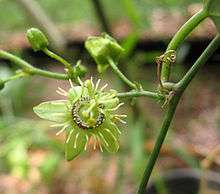Passiflora suberosa
Passiflora suberosa is a species of passionflower that is native to the Americas.[1] Its range stretches from Florida and the Lower Rio Grande Valley of Texas in the United States[2] south through Mexico, Central America, and the Caribbean to South America.[1] It is commonly known as corkystem passionflower due to the corkiness of older stems. The fruit is not hardy and transitions from green to indigo, purple and, lastly, black as it ripens. This species is a host plant for the caterpillars of the Gulf fritillary (Agraulis vanillae), Julia heliconian (Dryas iulia), Mexican silverspot (Dione moneta), red postman (Heliconius erato), and zebra heliconian (Heliconius charithonia).[2][3] It is a larval host plant for the glasswing butterfly (Acraea andromacha) in Australia.[4]
| Passiflora suberosa | |
|---|---|
 | |
| Flower | |
.jpg) | |
| Scientific classification | |
| Kingdom: | Plantae |
| Clade: | Tracheophytes |
| Clade: | Angiosperms |
| Clade: | Eudicots |
| Clade: | Rosids |
| Order: | Malpighiales |
| Family: | Passifloraceae |
| Genus: | Passiflora |
| Species: | P. suberosa |
| Binomial name | |
| Passiflora suberosa | |
| Synonyms[1] | |
|
Passiflora pallida L. | |
References
- "Passiflora suberosa, Passiflora suberosa". Germplasm Resources Information Network (GRIN). Agricultural Research Service (ARS), United States Department of Agriculture (USDA). Retrieved 2010-08-22.
- "Corkystem Passionflower - Passiflora suberosa". North American Butterfly Association. Retrieved 2010-08-22.
- Brown, Jr., Keith. "The Biology of Heliconius and Related Genera". Annual Review of Entomology. 26. doi:10.1146/annurev.en.26.010181.002235.
- Braby, M.F., Butterflies of Australia; Their Identification, Biology and Distribution. CSIRO Publishing 2000
External links
![]()
![]()